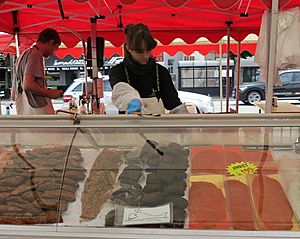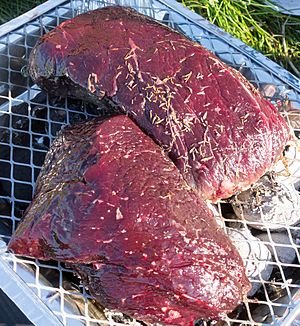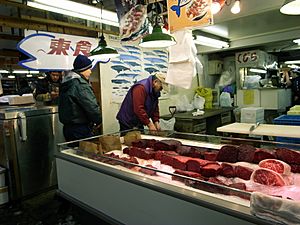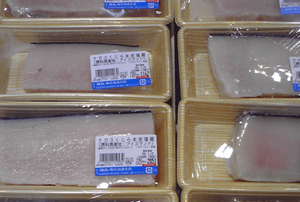Whale meat facts for kids

Whale meat includes meat from all cetaceans, which are sea mammals like whales, dolphins, and porpoises. It can be muscle, organs, skin (called muktuk), or fat (called blubber). Not many people eat whale meat today compared to other meats. Commercial whaling (hunting whales for their meat and oil) now happens in only a few countries, mainly Iceland, Japan, and Norway. However, in the past, people in Western Europe and colonial America used to eat it.
Some groups of people, like the Inuit in the Arctic or people in the Faroe Islands, still eat marine mammals as part of their traditional way of life. For some cultures, eating whale meat is not allowed, or it's only eaten when there's no other food. For others, it's a special dish. Indigenous groups say that eating whale meat is important for their culture to survive. However, many people are against eating whale meat because of worries about wildlife conservation, health issues (like mercury in the meat), and animal rights. Whale meat can be prepared in different ways, including being salted, so people who live far from the coast can also eat it.
Contents
History of Eating Whale Meat
Whales were hunted in Europe during the Middle Ages for their meat and oil. At that time, the Catholic Church considered sea creatures like whales to be "fish." This meant whale meat could be eaten during Lent and other times when people were not supposed to eat other meats. Some people also believed that parts of animals that lived in water, like whale or beaver tails, were "cold meat" and okay to eat on holy days.
Eating whale meat continued in Europe after the Middle Ages. However, too many whales were hunted, especially right whales in places like the Bay of Biscay. This meant there were not enough whales left in nearby oceans. So, European whalers, like the Basques, had to travel to the New World (the Americas) to find whales. The Dutch were also active in whaling during this time.
In early America, whalers sometimes ate the blubber after it was processed, calling it "cracklings." People in colonial America also ate meat from "blackfish" (or pilot whales). But as large-scale commercial whaling grew, most Americans stopped eating whale meat.
Whale Species Hunted
Today, Minke whales are one of the most common species still hunted in large numbers. Other types of baleen whales are endangered, but some indigenous groups still hunt them as part of their traditions. In recent years, whaling nations have also started hunting larger baleen whales again.
Researchers have studied whale meat sold in markets. For example, in Japan, they found that some meat sold as minke whale was actually from dolphins, porpoises, or even endangered species like fin whales and humpback whales. Japan has also started hunting North Pacific fin whales and sei whales for research. The meat from these whales is then sold.
Where Whale Meat is Eaten
In places like Norway, Iceland, and Alaska, whale meat might be served plain. But it can also be cured, marinated, or made into jerky.
Norway
In Norway, whale meat was a cheap and common food until the 1980s. People often cooked it in a pot with a little water to make a broth. It was usually served with potatoes, vegetables, and sometimes flatbrød (a type of flatbread).
Greenland
The Inuit people in Greenland have eaten whale meat for a long time as part of their culture. More recently, tourists have also started trying it. Some groups have found that commercial companies are asking traditional whalers to supply whale meat for supermarkets and even fancy hotels.
Japan
People in Japan have hunted whales for meat since before 800 AD. After World War II, when Japan's buildings and systems were damaged, whale meat became a very important source of protein for people.
In Japan today, whale meat is usually sold in two main cuts: belly meat and tail meat. In the early 1800s, there were 70 different cuts of whale meat known! The market for whale meat in Japan has become smaller in recent years. Some groups have claimed that some of the whale meat sold in Japan is caught illegally.
Native Alaskan Communities
For thousands of years, Native Alaskans in the Arctic have relied on whale meat. They get the meat from legal, non-commercial hunts that happen twice a year, in spring and autumn. The meat is then stored and eaten throughout the winter.
The Iñupiat people living on the coast of Alaska used to divide their whale catch into 10 parts. The fatty tail, which was considered the best part, went to the captain of the whaling boat. Other parts were given to his crew and those who helped with the hunt. The skin and blubber, called muktuk, from whales like the bowhead, beluga, or narwhal, is also highly valued. It can be eaten raw or cooked. Mikigaq is a dish made from fermented whale meat.
Faroe Islands
Whaling in the Faroe Islands has been happening since the first Norse settlers arrived. About 1,000 long-finned pilot whales are hunted each year, mostly in the summer. These hunts, called "grindadráp" in Faroese, are organized by the community.
Both the meat and blubber are stored and prepared in different ways, including a dish called Tvøst og spik. Fresh meat is often boiled. It can also be served as a steak (grindabúffur) with potatoes. The meat can also be hung outside to dry and then eaten in thin slices. Traditionally, whale meat was preserved by hanging salted pieces outdoors to dry in the wind. Today, people also store the meat and blubber in freezers.
In 2008, health officials in the Faroe Islands suggested that pilot whales might not be safe to eat because of chemicals like mercury found in the meat. They linked this to a higher rate of Parkinson's disease on the islands. Since 2011, the Faroese Food and Veterinary Authority has advised people not to eat certain parts of pilot whales and to limit how much whale meat they eat. They also advise pregnant or breastfeeding women not to eat whale meat at all.
United Kingdom
During World War II, the British government allowed whale meat to be sold without needing special ration coupons. However, it was not very popular because people found the smell unpleasant when cooking it, and the taste was often described as "bland."
After World War II, canned whale meat, called "whacon," was available. It was similar to corned beef but brownish. The government said it was very nutritious.
Environmental Impact of Whaling
Some groups have suggested that eating whale meat has a lower carbon footprint than eating beef. However, environmental groups like Greenpeace say that the survival of whale species is more important than lower carbon emissions. Many organizations, including Greenpeace and the Sea Shepherd Conservation Society, are worried that hunting whales, especially endangered species, is causing whale populations to drop. This could harm the oceans and their food chains in the future.
Efforts Against Whaling
Groups like the Sea Shepherd Conservation Society try to stop commercial whaling, with different levels of success.
See also
In Spanish: Carne de ballena para niños




